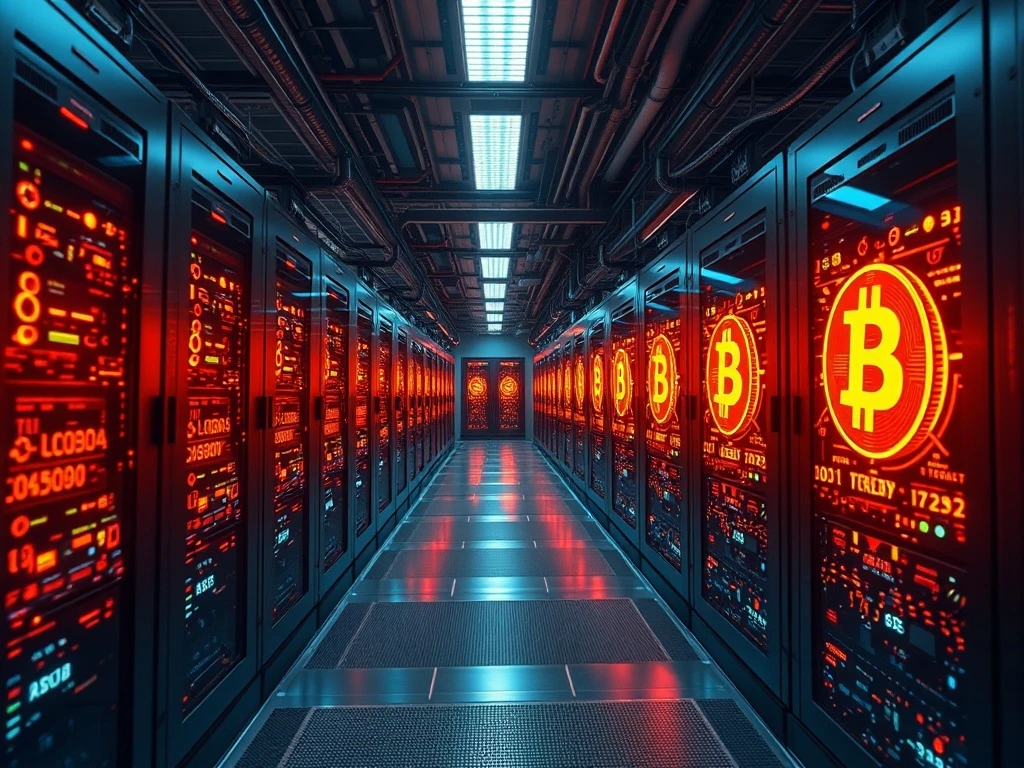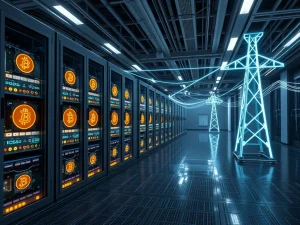Bitcoin Mining in 2025: Unlocking the Future of Digital Gold Rewards

Are you fascinated by the intricate world of cryptocurrencies? The landscape of Bitcoin mining continues its rapid evolution. As we navigate 2025, understanding the mechanics, economics, and technological advancements is crucial for enthusiasts and participants alike. This guide unpacks the complex processes, from hashrate dynamics to post-halving rewards, offering a comprehensive look at securing the world’s leading digital asset.
What is Bitcoin Mining? Decoding the Process
Bitcoin mining forms the bedrock of the BTC network. It ensures security and maintains operational integrity. Essentially, Bitcoin (BTC) miners gather pending transactions. They then bundle these into blocks. Miners repeatedly attempt hashing until they produce a hash meeting the network’s difficulty target. This trial-and-error process is highly competitive. The first miner to find a valid solution broadcasts their block. The network verifies it, and that miner earns a reward. If another miner solves the block first, your result becomes invalid. This is known as a “stale block.” You must then start over with a new set of transactions for the next block.
As of 2025, the block reward stands at 3.125 BTC. This follows the significant April 2024 halving event. Miners also receive transaction fees. These fees fluctuate based on network congestion. Competition is notably fierce. The barrier to entry remains high. Most miners now use specialized Application-Specific Integrated Circuit (ASIC) machines. Many also join mining pools. This stabilizes their income by sharing rewards with other participants.
Did you know? A common misconception suggests Bitcoin miners “solve complex cryptographic puzzles.” In reality, no puzzle exists. Miners simply make trillions of guesses every second. They aim to find one producing a hash below the network’s difficulty target.
How a Block is Actually Found
Here is a step-by-step look at how miners find a block on the Bitcoin network:
- A miner constructs a candidate block. This block uses pending transactions from the mempool.
- They add a special “coinbase transaction.” This transaction mints new BTC and claims transaction fees.
- The miner repeatedly hashes the block’s header using SHA-256. They adjust the nonce (a number used only once) during this process. The primary goal is finding a hash value lower than the network’s current difficulty target.
- Once a valid block is found, the miner broadcasts it to the network.
- Other nodes independently verify its proof-of-work and transactions. They then add it to their local copy of the blockchain.
If two miners find valid blocks almost simultaneously, the blockchain can briefly split. The network resolves this when one branch accumulates more proof-of-work (PoW). This branch becomes the main chain. The other is discarded as a “stale” block. This system ensures Bitcoin’s consensus always follows the chain with the greatest accumulated work. Consequently, forks remain short-lived, and the ledger stays resilient.
Mining Rewards After the 2024 Bitcoin Halving
When Bitcoin’s fourth Bitcoin halving occurred in April 2024, the block reward significantly decreased. It fell from 6.25 BTC to 3.125 BTC. This fixed reward is what every miner competes for. With approximately 144 blocks mined daily, the network issues roughly 450 new BTC each day. This figure does not include transaction fees.
The Fee Wildcard and Unpredictable Mining Rewards
Transaction fees introduce unpredictability into miner earnings. Around the April 2024 halving, Bitcoin saw a surge in activity. This surge was triggered by the launch of Runes, a new token protocol. Runes flooded the mempool with transactions. For a short period, transaction fees actually surpassed the 3.125 BTC block reward. Some blocks paid miners tens of BTC in fees alone. This represented a rare windfall compared to usual baselines. However, these spikes were short-lived. By mid-2025, median fees had returned to normal levels as demand cooled. This pattern is familiar: whenever the mempool overflows, whether from new protocols, hype cycles, or major on-chain events, users outbid each other for space. They compete for limited space in Bitcoin’s 1 MB-4 MB block window. Once the backlog clears, bidding wars end, and fee revenue returns to baseline.
Hashrate and Difficulty: The Constant Race for Efficiency
Mining power is quantified by hashrate. This represents the total computing power dedicated to securing the Bitcoin network. Bitcoin maintains block times close to 10 minutes. It achieves this by adjusting mining difficulty every 2,016 blocks, or roughly every two weeks. This cycle ensures network stability. When the hashrate increases, blocks are mined faster than intended. The next adjustment therefore raises difficulty. Conversely, if the hashrate falls, blocks take longer to produce. The network lowers difficulty to compensate. For miners, higher difficulty means earning fewer BTC for the same amount of work. Consequently, each difficulty retarget feels like an “earnings report.” It resets revenue expectations for the next two weeks.
In 2025, both the hashrate and difficulty are at record highs. New, more efficient ASIC fleets continually come online. This pushes difficulty upward. It also forces older rigs out of the market. Operators with high power costs are typically the first to shut down. They must find cheaper energy or benefit from sudden spikes in price and fees to stay afloat. Bitcoin mining remains a constant race: only the most efficient setups survive when margins tighten.
Did you know? Bitcoin’s 10-minute block time was a deliberate compromise. It is short enough for reasonably quick confirmations. Yet, it is long enough to minimize the risk of simultaneous block discoveries and chain splits.
Advanced ASIC Miners and Setups in 2025
Bitcoin mining focuses heavily on maximizing efficiency from every watt of power. By 2025, the industry had evolved significantly beyond hobby rigs. Modern operations demand industrial-grade solutions.
The Hardware Miners Use
At the core of nearly every modern mining farm are ASIC miners. These machines are purpose-built exclusively for Bitcoin. Their efficiency is measured in joules per terahash (J/TH). This indicates how much energy is required to produce one unit of hashing power.
- Air-cooled units: These remain industry workhorses. Models like Bitmain’s S21 (17.5 J/TH) and MicroBT’s M60S (18.5 J/TH) dominate large farms. High-end versions such as the Bitmain S21 XP push efficiency further, reaching around 13.5 J/TH.
- Hydro and immersion rigs: These represent the cutting edge. Models like the S21 XP Hyd rate near 12 J/TH. They deliver top-tier performance. However, they demand specialized liquid-cooling systems, which adds cost and operational complexity.
Cooling Approaches
Cooling has become a defining factor in large-scale mining operations:
- Air: This method is the cheapest and easiest to deploy. However, it is noisy and less power-dense.
- Immersion: This involves submerging rigs in dielectric fluid. It boosts uptime and overclocking potential. Farms like Riot’s Rockdale dedicate entire halls to this setup.
- Hydro: These are closed-loop water systems built directly into the machines. They offer top efficiency but require major infrastructure investment.
Fleet Strategy
Mining economics can shift weekly. Operators therefore adapt their fleets using both hardware choices and firmware tuning:
- Low-power (underclocking): This reduces output but boosts efficiency. It is ideal when Bitcoin’s hashprice (revenue per unit of compute) is weak.
- Overclocking: This trades efficiency for higher throughput. Miners use it when BTC’s price or transaction fees surge.
The golden rule in 2025 emphasizes efficiency over raw power. This holds true unless you access ultra-cheap, reliable electricity. Such access can justify higher consumption.
Mining Pools, Payouts, and Understanding Hashprice
Nearly all miners today direct their machines to pools. These pools bundle hashrate from thousands of participants. Pools stabilize mining rewards. Instead of waiting to personally “win” a block, miners receive steady payouts. These payouts are based on their contributed share. A handful of major pools dominate the network. These include Foundry USA, AntPool, F2Pool, and ViaBTC. Their activity is easily tracked on live dashboards, which show which pool mined the latest block.
How Pools Pay
Mining pools utilize various payout methods:
- Pay-per-share (PPS) and full pay-per-share (FPPS): These offer predictable payouts for every submitted share. FPPS specifically includes a transaction fee estimate.
- Pay-per-last-N-shares (PPLNS): This method is riskier. Rewards only come when the pool successfully finds blocks. It features higher variance but sometimes offers better returns.
The choice of payout method depends on your preference. Do you prefer steady cash flow (PPS/FPPS) or can you tolerate volatility for potential upside (PPLNS)?
Hashprice: The Miner’s Key Metric
Miner income is typically measured as hashprice. This is the USD earned per petahash of hashrate per day. Hashprice increases with Bitcoin’s price and transaction fees. However, it declines as network difficulty rises. As of October 2025, the spot hashprice hovered around $51 per petahash per second per day. Break-even levels vary widely. They depend on machine efficiency and electricity cost. Miners with cheap or flexible power deals therefore tend to survive downturns more easily.
Did you know? Bitcoin miners often hedge, much like energy companies. They use tools such as hashrate forwards and fixed-payout contracts. This allows them to lock in future revenue instead of riding hashprice volatility.
Energy, Geography, and Sustainable Bitcoin Mining
Energy costs, local grid policies, and geography significantly determine miner profitability. These factors dictate which miners stay profitable and which ones face financial pressure.
How Much Energy Does Bitcoin Use?
Estimates for Bitcoin’s energy consumption vary. In May 2025, Digiconomist estimated Bitcoin’s annualized electricity consumption at roughly 190 terawatt-hours. This is comparable to the yearly power use of a mid-sized country such as Poland or Thailand. Other estimates, including data from the Cambridge Bitcoin Electricity Consumption Index, place Bitcoin’s share of global electricity use at approximately 0.8%. In the United States, government data suggests crypto mining accounts for between 0.6% and 2.3% of national power demand.
Miners as Flexible Power Users
Importantly, miners act as flexible loads on the grid. In Texas, for instance, the Electric Reliability Council of Texas market pays miners to power down during peak demand. Riot Platforms disclosed that in August 2023, these demand-response credits were worth the equivalent of 1,136 BTC. Interruptible power deals can significantly alter the economics of Bitcoin mining. They provide a strategic advantage.
Where the Machines Are
After China banned crypto mining in 2021, a large portion of displaced capacity migrated. It moved to regions with abundant energy resources. Texas became a focal point. Canadian provinces with hydroelectric capacity and natural gas also attracted significant deployments. By 2025, public mining companies operated an estimated 7.4 gigawatts of capacity across the US and Canada. The deciding factors are clear: cheap and stable power, favorable regulatory terms, and grid programs that compensate miners for flexible load curtailment during peak demand. Ultimately, these elements shape the global distribution and sustainability of Bitcoin’s critical infrastructure.










